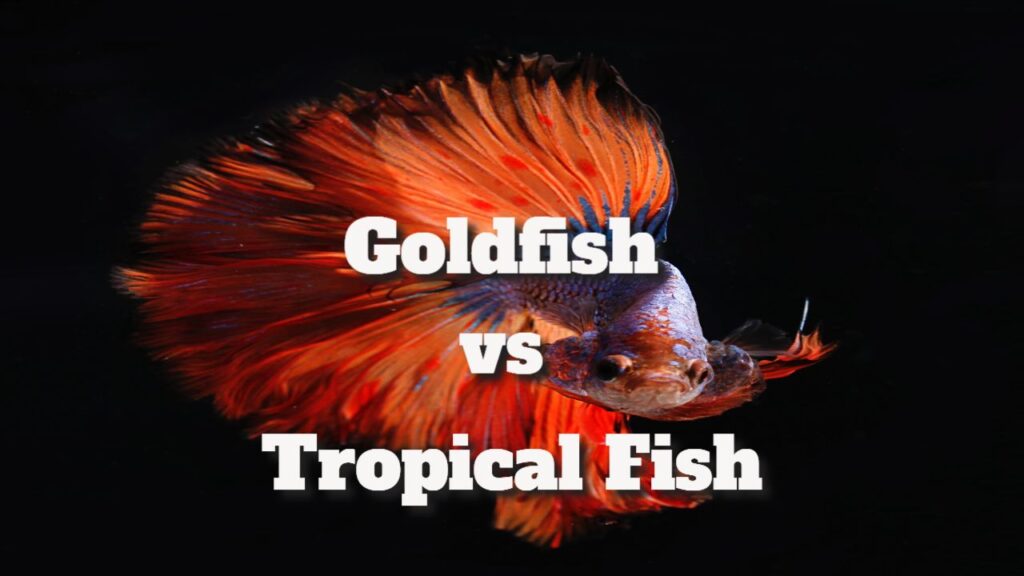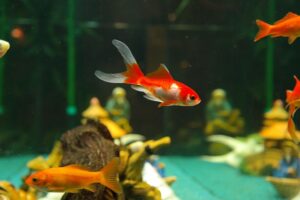Goldfish vs Tropical Fish: Essential Differences To know
Keeping fish as pets is a common hobby all around the world. However, selecting the appropriate fish species can be difficult for individuals new to aquariums. Goldfish and tropical fish are two of the most popular types of pet fish. Despite their similar appearances, the two species have significant distinctions.
Goldfish are freshwater fish native to East Asia typically housed in a cold-water aquarium. They are tough and withstand various water conditions, making them excellent for beginners. Tropical fish, on the other hand, come from warm waters and must be kept in a heated aquarium to live. They are more sensitive to water conditions than Goldfish and require more attention.
Goldfish are typically spherical with a short tail, whereas tropical fish come in various forms, sizes, and colours. Another distinction is their conduct. Understanding the distinctions between these two types of fish is critical to selecting the best species for your aquarium.
Basic requirements
This section examines two essential requirements: Tank size and environment and water temperature and composition.
Tank size and surroundings
The size of your tank is critical to the health of your fish. Generally, one Goldfish requires at least 20 litres of water, with an extra 10 litres required for each subsequent Goldfish. A good rule of thumb is to provide each centimetre of fish with at least 1 litre of water.
Consider the surrounding surroundings as well as the tank's dimensions. Tropical fish require moderate water flow and plenty of hiding places to thrive, whereas goldfish prefer a massive tank with little water movement. Plants, rocks, and caves can provide hiding places for the fish, and a filter can assist in keeping the water clean.
Temperature and composition of the water
Goldfish are cold-water fish that like water temperatures ranging from 18 to 24°C. Water temperatures of 24-28 degrees Celsius are ideal for tropical fish. It is critical to monitor and adjust the water temperature periodically.
In terms of water composition, Goldfish prefer a pH of 7.0-7.5 and a hardness of 100-150 ppm. Tropical fish, on the other hand, require water with a slightly acidic pH of 6.5-7.0 and a hardness of 100-200 ppm.
If you follow these basic guidelines, your Goldfish or tropical fish will thrive in their surroundings and provide you with years of delight.
Nutrition and feeding
Dietary differences
Goldfish are omnivores, which consume both plant and animal diets. They have a basic digestive system and can subsist on a diet of fish flakes or pellets. To stay healthy and happy, they must supplement their diet with fresh veggies such as peas, spinach, and lettuce. Goldfish also enjoy live or frozen foods like bloodworms and brine prawns, which provide critical minerals and variety to their diet.
Some people, known as carnivores, eat meat, such as prawns or fish.
Frequency of feeding
Goldfish have a sluggish metabolism and can go between feedings for extended periods. It is best to feed them once or twice a day and only as much as they can ingest in a few minutes. Overfeeding can cause health problems such as constipation and swim bladder difficulties.
Depending on the species, they may require feeding twice or three times per day, with smaller portions each time. Uneaten food can quickly contaminate aquarium water, causing health concerns in the fish. Therefore, it's critical to avoid overfeeding.
Knowing your fish's nutritional demands and feeding patterns is critical to ensuring they get the proper food and stay healthy. You may help your fish grow in their aquarium by providing balanced food and adequate portioning.
Life expectancy and health
Common health issues
Parasites: Parasites like ichthyosis, velvet, and gill worms can damage goldfish and tropical fish. A lack of energy, anorexia, and white patches on the body or fins are all symptoms of these parasites.
Fungal infections: Fungal infections in goldfish and tropical fish can arise due to skin injury or poor water quality. White or grey patches on the skin or fins and ragged or frayed fins are symptoms.
Bacterial infections can arise in Goldfish and tropical fish due to poor water quality, damage, or stress. Some symptoms are redness, swelling, and ulcers on the skin or fins.
Average life expectancy
The length of life of tropical fish such as goldfish is determined by species, nutrition, water quality, and care. Goldfish live longer than tropical fish, with some species surviving up to 20 years. However, species and care considerations can have an impact on this.
On the other hand, tropical fish have a shorter life span, with most species living for 3 to 5 years on average. Some species, however, such as angelfish and discus fish, can survive for up to ten years or longer if properly cared for.
A healthy, stress-free environment for fish can contribute to a healthier life.
Maintenance and care
Cleaning procedures
You must often clean their tank if you want your fish to stay healthy. However, the cleaning procedures for Goldfish and tropical fish differ. To avoid contamination, removing uneaten food or waste from the tank daily is also essential.
Removing all food residues from the tank daily is also essential.
Behavioural characteristics
Social behavior
Regarding social behaviour, Goldfish tend to be more solitary than tropical fish. While some tropical fish species prefer to live alone, many thrive in groups and need the company of their conspecifics to feel safe and comfortable. On the other hand, Goldfish are generally content to live alone or with only a few conspecifics.
Activity level
Goldfish are known for their leisurely swimming style and are often seen lazily floating around in their tank. This is because tropical fish come from warmer waters and must be more active to maintain their body temperature.
Overall, the behavioural characteristics of Goldfish and tropical fish are quite different. It is important to consider these differences when deciding which fish species to keep in your aquarium.
Frequently asked questions
What are the main differences between setting up an aquarium for Goldfish and tropical fish?
Goldfish and tropical fish require different aquarium setups. They also produce more waste, so a larger filter is required. Goldfish prefer cooler water temperatures, so they do not need a heater.
Can Goldfish thrive in the same water conditions as tropical fish?
When housed alongside tropical fish, goldfish can degrade water quality because of their higher waste production and need for cooler water temps.
What are the temperature requirements for keeping Goldfish compared to tropical species?
Goldfish prefer cooler water temperatures between 18-24°C, while tropical fish require warmer water temperatures between 24-28°C.
Is the care of Goldfish more or less demanding than that of tropical fish?
Still, you’ll have to replace the water more often and buy a giant filter because they’re more space-hungry and waste-producing.
How do the nutritional requirements of Goldfish differ from those of tropical fish?
Goldfish and tropical fish have different nutritional requirements. Goldfish are omnivorous and require a diet rich in plant matter, such as flakes, pellets and vegetables. Tropical fish are more diverse in their dietary needs and require a variety of foods, including flakes, pellets, frozen or live food and vegetables.
Can Goldfish and tropical fish live side by side in the same aquarium?
Poor water quality for tropical fish can be caused by goldfish, which have variable water temperatures, space requirements, and waste production.
The post Goldfish vs Tropical Fish: Essential Differences To know appeared first on Unity Pets.
The post Goldfish vs Tropical Fish: Essential Differences To know appeared first on https://gqcentral.co.uk
The Article Goldfish vs Tropical Fish: Essential Differences To know First Appeared ON
: https://ad4sc.com







Comments are closed